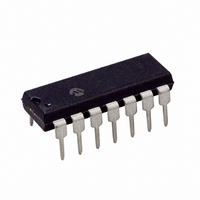MCP2036-I/P Microchip Technology, MCP2036-I/P Datasheet - Page 10

MCP2036-I/P
Manufacturer Part Number
MCP2036-I/P
Description
IC KEYLESS ENTRY AFE 14-PDIP
Manufacturer
Microchip Technology
Type
Sensor Interfacer
Specifications of MCP2036-I/P
Package / Case
14-DIP (0.300", 7.62mm)
Applications
Analog I/O
Mounting Type
Through Hole
Product
Analog Front End
Supply Voltage (max)
5.5 V
Supply Voltage (min)
2.7 V
Supply Current
6.8 mA
Maximum Operating Temperature
+ 85 C
Minimum Operating Temperature
- 40 C
Mounting Style
Through Hole
Number Of Channels
1
Clock Frequency Max
2MHz
Slew Rate
0.6V/µs
Turn On Time
4µs
Sensor Case Style
DIP
Operating Temperature Range
-40°C To +85°C
No. Of Pins
14
Rohs Compliant
Yes
Supply Voltage Range
2.7 To 5.5V
Lead Free Status / RoHS Status
Lead free / RoHS Compliant
Lead Free Status / RoHS Status
Lead free / RoHS Compliant, Lead free / RoHS Compliant
Available stocks
Company
Part Number
Manufacturer
Quantity
Price
Company:
Part Number:
MCP2036-I/P
Manufacturer:
MICROCHIP
Quantity:
12 000
MCP2036
Substituting in the equation for an RC network:
EQUATION 3-4:
The peak-to-peak amplitude of the resulting triangular
waveform, at the coil driver input, is shown in
Equation
EQUATION 3-5:
From the previous equation, the designer should
choose values for V
above, the value of C
EQUATION 3-6:
The amplitude of the pulsed current applied to key
inductors will be:
EQUATION 3-7:
DS22186C-page 10
C
IN
Note:
Note:
=
ΔV
------------------------------------------------------------------ -
R
2ΔV
IN
=
•
3-5:
=
V
ln
V
---------- -
V
(600mV) for best performance.
Assuming a power supply of 5V and
V
have about 320pF. A 330pF capacitor will
be used.
PKPK
⎛
⎜
⎝
DD
2
(
V
--------------------------------------- -
V
PKPK
PKPK
G
V
DD
DD
DD
DRV
•
t
ΔI
------------------------------------------ -
1
=
1
–
+
=500mV, for R
2 ⁄
V
V
+
–
should not exceed specified value
=
V
PKPK
PKPK
V
PKPK
exp
exp
- Gain of Coil Driver
DD
+
IN
PKPK
V
ΔV
PKPK
will be:
⎛
⎝
⎛
⎝
•
⎞
⎟
⎠
----------------- -
R
----------------- -
R
=
------------------------------------------ -
1
and R
)
1
=
IN
IN
•
+
–
-------------------------------------------------------------------------------------
2 F R
t –
t –
•
C
C
[
2ΔV
•
exp
exp
1
G
IN
IN
–
•
DRV
IN
⎞
⎠
⎞
⎠
IN
⎛
⎝
⎛
⎝
exp
. Using the equation
----------------- -
R
----------------- -
R
IN
=3.9KΩ, C
IN
IN
•
t –
t –
– (
C
C
ln
t RC
IN
IN
⎛
⎜
⎝
1
⁄
--------------------------------------- -
V
V
⎞
⎠
⎞
⎠
DD
DD
)
+
–
IN
]
V
V
should
PKPK
PKPK
⎞
⎟
⎠
This current produces a pulsed voltage to key inductors
ends. The amplitude of this voltage will be:
EQUATION 3-8:
The total voltage across both the reference and sensor
coils would be double (two series inductors). For a
specific power supply voltage, half of this power supply,
relative to the voltage reference, is available for output
amplifier/detector. Assuming a 30% margin, the
desired gain for the detector should be about:
EQUATION 3-9:
The gain of the amplifier is user-settable, using an
external resistor, R
be determined using the following equation:
EQUATION 3-10:
With a 10-bit ADC, using oversampling and averaging
techniques, the effective resolution is close to 11 bits.
As shown in AN1239, “Inductive Touch Sensor
Design”, the typical shift in sensor impedance is typi-
cally 3-4%, so the actual number of counts per press is
typically between 20 and 40 counts. In this way, the
microcontroller firmware could easily detect press
event.
Note:
Note:
ΔU
For a PWM frequency of 2 MHz and
inductor value of 2.7µH, the amplitude of
pulsed voltage will be:
For a power supply of 5V and ΔU = 10mV,
the resulted gain is 81. To obtain this gain,
R
=
L - Inductance of Key Inductor
F - PWM Frequency
GAIN
L
Gain R
Gain
•
ΔI
----- -
Δt
= 820kOhm should be used.
GAIN.
=
ΔU
=
∼
L V
=
70%
---------------------------------
© 2009 Microchip Technology Inc.
•
The value of that resistor will
GAIN
10.8mV
2 ΔU
PKPK
•
•
/10kOhm
⎛
⎝
V
---------- -
DD
2
•
G
⎞
⎠
DRV
•
2F


















